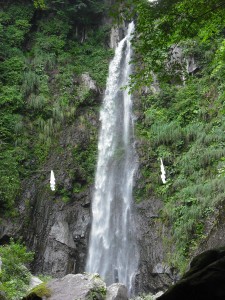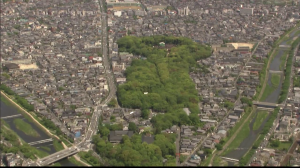 Let me briefly introduce myself first. My name is Aike Rots. I have BA degrees in Japanese Studies and Comparative Religion from the University of Leiden in the Netherlands. Afterwards, I followed the MA program in Japanese Religions at the School of Oriental and African Studies in London. Last year, I started my work as a PhD candidate under Mark Teeuwen at the University of Oslo in Norway (see my profile). I am currently spending a couple of months in Kyoto in order to conduct interviews, collect materials and attend events.
Let me briefly introduce myself first. My name is Aike Rots. I have BA degrees in Japanese Studies and Comparative Religion from the University of Leiden in the Netherlands. Afterwards, I followed the MA program in Japanese Religions at the School of Oriental and African Studies in London. Last year, I started my work as a PhD candidate under Mark Teeuwen at the University of Oslo in Norway (see my profile). I am currently spending a couple of months in Kyoto in order to conduct interviews, collect materials and attend events.
In my PhD research I am trying to ‘map’ the variety of definitions and conceptualisations of Shinto that exist, and analyse the contemporary discourse on Shinto and ecology. I believe that the image of Shinto John is advocating on this weblog – green, pluralist and internationally oriented – has gained significant popularity in recent years. As such, this weblog represents an important contemporary development in Shinto.

Does nature worship lead to nature protection?
‘Shinto’ is, I believe, an abstraction – an ideological construction, projected upon actual places and practices. That does not make it less real, of course – concepts such as ‘religion’ and ‘society’ are also abstract categories, yet they are very real as they structure our thought and policies. It means that abstract notions considering the essence of Shinto do not necessarily correspond to the concrete concerns, beliefs and practices of local priests and practitioners. Accordingly, rather than trying to come up with an alternative definition myself, I will try to give an overview of the various existing definitions, and analyse ways in which they relate. If you are interested in this topic, have a look at this blogpost.
While taking into account historical factors, my research has a strong contemporary focus. Until recently, most research on Shinto and kami worship focused on their development in Japanese history. The postwar period, however, received little scholarly attention. This seems to be gradually changing. In fact, in the past sixty-five years shrine Shinto has gone through some significant changes. One of these is the reinvention of Shinto as an ancient, primordial tradition of nature worship and animism – and, accordingly, the assertion that Shinto worldviews and practices are fundamentally ecologically friendly, and may even be employed as a blueprint for new environmental ethics.
Some critics have argued that such ideas are little more than PR, and pointed to the lack of any significant attention to environmental problems on the part of the Shinto establishment. Their critique is certainly justified, yet it is an undeniable fact that in recent years more and more attention is paid to Shinto, nature and environmental preservation – if only in academic discourse.
Shinto environmentalist paradigm
In Japan, the ‘Shinto environmentalist paradigm’ has been developed by scholars from a variety of disciplines. They include Shinto scholars Sonoda Minoru and Ueda Masaaki, philosopher Umehara Takeshi, ecologist Miyawaki Akira, architect Ueda Atsushi and religious studies scholar Yamaori Tetsuo, among others. These men argue that ancient Japanese society developed ways to live in harmony with nature, which have been largely forgotten in the modern period; thus, much of their work is characterised by a nostalgic longing for this ancient past.

Aerial view of Shimogamo's green surrounds
Central to their ideas is the notion of chinju no mori: sacred shrine forests, which supposedly have been preserved for many centuries. Accordingly, rather than engaging with abstract issues such as pollution, climate change or deforestation in foreign countries, most environmentalist practices by shrine priests and organisations focus on the preservation of local chinju no mori. Several projects have been developed to protect these, and contribute to environmental awareness among visitors. High-profile examples include Tadasu no Mori Zaidan, affiliated with Shimogamo Jinja in Kyoto, and NPO Hibiki, affiliated with Meiji Jingū in Tokyo. Meanwhile, much necessary expertise on forest preservation and ecology is shared by the umbrella organisation Shasō Gakkai, by means of forestry trainings and symposiums.
In the following two months, I hope to be able to collect more data by interviewing shrine priests, visit chinju no mori, and learn about shrine projects. I am sure there are many more local initiatives, with which I am not yet familiar. I welcome any comments or suggestions; feel free to send me an email (aikerots[at]gmail.com) any time. You can also follow my experiences on my bilingual weblog, which I try to update regularly – although I am not as prolific a blogger as John.

Hi, Shinto is absolutely ecological and even after the war, the mainstream agriculture did not use artificial fertilizers, only ensured a total harmony of living being on the field and around it.
Also Japanese fisheries are totally dependent on such harmony of fields on the mountains, from where the rivers flow into the sea bringing in minerals and food for fish.
I cannot give you the exact document now, yet I am aware that Edo, even though a city with 1.1 milion inhabitants had no waste. It was 100% ecological city. Everything collapsed with the war.
Also due to the danger of fires, Edo was a place with active sharing economy. All of this is related to Shinto.
Thank you for the input, that’s an interesting perspective which it would be good to know more about. There’s a book about Edo-era ecoology I remember seeing, in which the Satoyama played a large part…